Evaluation of the Effective Active Power Reserve for Fast Frequency Response of PV with BESS Inverters Considering Reactive Power Control
Abstract
:1. Introduction
- Evaluate the effective active power reserve provided by PV systems with BESS, considering the impact of reactive power control strategies used for voltage regulation;
- Evaluate the efficiency of active power reserve provision that VPP can provide at the connection point with the higher level of the grid for frequency regulation, considering grid losses;
- Define a new parameter able to clearly compare the different reactive control strategies in terms of active power reserve efficiency.
2. Voltage and Frequency Regulation in Italian Standards
- is the voltage at node h;
- is the voltage at node k;
- is the conductance of the electrical line h–k;
- is the susceptance of the electrical line h–k;
- is the phase between node h and node k.
- A: , PF = 1;
- B: , PF = 1;
- C: , PF = PF max.
3. Description of the PV with BESS System Model
- P–V curves: RMSE < 1.5% with uniform distribution of irradiance and temperature and RMSE < 3% with non-uniform distribution of irradiance and temperature [30];
- BESS voltage: RMSE = 2% in continuous discharge condition and RMSE = 1.7% in pulse current discharge condition [31];
- Inverter efficiency: RMSE varies from 1.69% to 3.4% depending on the specific inverter [37].
4. Evaluation of the Effective Active Power Reserve
- Subscript “i = 0”: quantities related to the case = 0;
- Subscript “i = 1”: quantities related to the case =.
- Starting from and , evaluate ,, and using Equations (4), (5) and (12);
- Starting from , evaluate using Equation (4);
- Evaluate using Equation (14).
5. Impact of Reactive Power Control on Active Power Reserve Efficiency
6. Impact of Voltage Control Strategies on Active Power Reserve Efficiency Provided by an LV Grid
- N = 0: no regulation (PF = 1);
- N = 1: fixed PF = 0.9;
- N = 2: PF = f(P);
- N = 3: Q = f(V);
- N = 4: PF = f(P,V) (mixed strategy).
7. Conclusions
Author Contributions
Funding
Conflicts of Interest
References
- European Commission. Annex to the Communication from the Commission to the European Parliament, the European Council, the Council, the European Economic and Social Committee and the Committee of the Regions. In The European Green Deal; European Commission: Brussels, Belgium, 2019. [Google Scholar]
- Gregory, M. Beyond 100% renewable: Policy and practical pathways to 24/7 renewable energy procurement. Electr. J. 2020, 33, 106695. [Google Scholar]
- Choudhary, P.; Srivastava, R.K. Sustainability perspectives- a review for solar photovoltaic trends and growth opportunities. J. Clean. Prod. 2019, 227, 589–612. [Google Scholar] [CrossRef]
- Chiacchio, F.; Famoso, F.; D’Urso, D.; Cedola, L. Performance and Economic Assessment of a Grid-Connected Photovoltaic Power Plant with a Storage System: A Comparison between the North and the South of Italy. Energies 2019, 12, 2356. [Google Scholar] [CrossRef] [Green Version]
- Ciriminna, R.; Albanese, L.; Pecoraino, M.; Meneguzzo, F.; Pagliaro, M. Solar Energy and New Energy Technologies for Mediterranean Countries. Glob. Chall. 2019, 3, 1900016. [Google Scholar] [CrossRef] [PubMed]
- Karimi, M.; Mokhlis, H.; Naidu, K.; Uddin, S.; Bakar, A. Photovoltaic penetration issues and impacts in distribution network–A review. Renew. Sustain. Energy Rev. 2016, 53, 594–605. [Google Scholar] [CrossRef]
- Khan, B.; Tanwar, S. Issues Associated With Microgrid Integration. Adv. Comput. Electr. Eng. 2019, 2019, 252–264. [Google Scholar] [CrossRef] [Green Version]
- Delfanti, M.; Merlo, M.; Monfredini, G.; Cerretti, A.; De Berardinis, E. Voltage regulation issues for smart grid. In Proceedings of the CIGRE 2011 Bologna Symposium-The Electric Power System of the Future: Integrating Supergrids and Microgrids, Paris, France, 13–15 September 2011. [Google Scholar]
- Ruban, N.; Kinshin, A.; Gusev, A. Review of grid codes: Ranges of frequency variation. In Proceedings of the International Youth Scientific Conference “Heat and Mass Transfer in the Thermal Control System of Technical and Technological Energy Equipment” (HMTTSC 2019), Tomsk, Russia, 9 August 2019. [Google Scholar]
- Wooyoung, C. Grid-Connected Inverter to Mitigate Voltage-Based Power Quality Problems; The University of Wisconsin-Madison: Madison, WI, USA, 2019. [Google Scholar]
- Wu, Y.K.; Tang, K.T. Frequency Support by BESS–Review and Analysis. Energy Procedia 2019, 156, 187–191. [Google Scholar] [CrossRef]
- Greenwood, D.; Lim, K.; Patsios, C.; Lyons, P.; Lim, Y.; Taylor, P. Frequency response services designed for energy storage. Appl. Energy 2017, 203, 115–127. [Google Scholar] [CrossRef]
- Meng, L.; Zafar, J.; Khadem, S.K.; Collinson, A.; Murchie, K.C.; Coffele, F.; Burt, G.M. Fast Frequency Response From Energy Storage Systems—A Review of Grid Standards, Projects and Technical Issues. IEEE Trans. Smart Grid 2020, 11, 1566–1581. [Google Scholar] [CrossRef] [Green Version]
- Yagami, M.; Kimura, N.; Tsuchimoto, M.; Tamura, J. Power system transient stability analysis in the case of high-penetration photovoltaics. In Proceedings of the 2013 IEEE Grenoble Conference, Piscataway, NJ, USA, 16–20 June 2013; pp. 1–6. [Google Scholar]
- Dreidy, M.; Mokhlis, H.; Mekhilef, S. Inertia response and frequency control techniques for renewable energy sources: A review. Renew. Sustain. Energy Rev. 2017, 69, 144–155. [Google Scholar] [CrossRef]
- Asmus, P. Microgrids, Virtual Power Plants and Our Distributed Energy Future. Electr. J. 2010, 23, 72–82. [Google Scholar] [CrossRef]
- Marzooghi, H.; Verbic, G.; Hill, D.J. Aggregated demand response modelling for future grid scenarios. Sustain. Energy Grids Netw. 2016, 5, 94–104. [Google Scholar] [CrossRef] [Green Version]
- Cipcigan, L.; Taylor, P.; Lyons, P. A dynamic virtual power station model comprising small-scale energy zones. Int. J. Renew. Energy Technol. 2009, 1, 173. [Google Scholar] [CrossRef]
- Chen, S.; Zhang, T.; Gooi, H.B.; Masiello, R.D.; Katzenstein, W. Penetration Rate and Effectiveness Studies of Aggregated BESS for Frequency Regulation. IEEE Trans. Smart Grid 2015, 7, 1. [Google Scholar] [CrossRef]
- Tang, W.J.; Yang, H.T. Optimal Operation and Bidding Strategy of a Virtual Power Plant Integrated With Energy Storage Systems and Elasticity Demand Response. IEEE Access 2019, 7, 79798–79809. [Google Scholar] [CrossRef]
- Nosratabadi, S.M.; Hooshmand, R.A.; Gholipour, E. A comprehensive review on microgrid and virtual power plant concepts employed for distributed energy resources scheduling in power systems. Renew. Sustain. Energy Rev. 2017, 67, 341–363. [Google Scholar] [CrossRef]
- Comodi, G.; Giantomassi, A.; Severini, M.; Squartini, S.; Ferracuti, F.; Fonti, A.; Cesarini, D.N.; Morodo, M.; Polonara, F. Multi-apartment residential microgrid with electrical and thermal storage devices: Experimental analysis and simulation of energy management strategies. Appl. Energy 2015, 137, 854–866. [Google Scholar] [CrossRef]
- Samarakoon, K.; Ekanayake, J.; Jenkins, N. Investigation of Domestic Load Control to Provide Primary Frequency Response Using Smart Meters. IEEE Trans. Smart Grid 2011, 3, 282–292. [Google Scholar] [CrossRef]
- Rezkalla, M.M.; Zecchino, A.; Pertl, M.; Marinelli, M. Grid frequency support by single-phase electric vehicles employing an innovative virtual inertia controller. In Proceedings of the 2016 51st International Universities Power Engineering Conference (UPEC), Piscataway, NJ, USA, 6–9 September 2016; pp. 1–6. [Google Scholar]
- Rezkalla, M.M.; Zecchino, A.; Martinenas, S.; Prostejovsky, A.; Marinelli, M. Comparison between synthetic inertia and fast frequency containment control based on single phase EVs in a microgrid. Appl. Energy 2018, 210, 764–775. [Google Scholar] [CrossRef] [Green Version]
- Marconato, R. Electric Power Systems; CEI: Milan, Italy, 2002. [Google Scholar]
- Italian Standard, CEI. Reference Technical Rules for the Connection of Active and Passive Users to the LV Electrical Utilities; CEI: Milan, Italy, 2019. [Google Scholar]
- Italian Standard, CEI. Reference Technical Rules for the Connection of Active and Passive Consumers to the HV and MV Electrical Networks of Distribution Company; CEI: Milan, Italy, 2019. [Google Scholar]
- Tina, G.M.; Celsa, G. Active and reactive power regulation in grid-connected PV systems. In Proceedings of the 2015 50th International Universities Power Engineering Conference (UPEC), Piscataway, NJ, USA, 1–4 September 2015; pp. 1–6. [Google Scholar]
- Tina, G.M. Simulation Model of Photovoltaic and Photovoltaic/Thermal Module/String under Nonuniform Distribution of Irradiance and Temperature. J. Sol. Energy Eng. 2016, 139, 021013. [Google Scholar] [CrossRef]
- Yao, L.W.; Aziz, J.A.; Kong, P.Y.; Idris, N.R.N.; Aziz, M.J.A. Modeling of lithium-ion battery using MATLAB/simulink. In Proceedings of the IECON 2013-39th Annual Conference of the IEEE Industrial Electronics Society, Piscataway, NJ, USA, 10–13 November 2013; pp. 1729–1734. [Google Scholar]
- Chen, M.; Rincon-Mora, G. Accurate Electrical Battery Model Capable of Predicting Runtime and I–V Performance. IEEE Trans. Energy Convers. 2006, 21, 504–511. [Google Scholar] [CrossRef]
- Wen, J.; Yu, Y.; Chen, C. A Review on Lithium-Ion Batteries Safety Issues: Existing Problems and Possible Solutions. Mater. Express 2012, 2, 197–212. [Google Scholar] [CrossRef]
- Millner, A. Modeling Lithium Ion battery degradation in electric vehicles. In Proceedings of the 2010 IEEE Conference on Innovative Technologies for an Efficient and Reliable Electricity Supply, Piscataway, NJ, USA, 27–29 October 2010; pp. 349–356. [Google Scholar]
- Tina, G.M.; Celsa, G. A Matlab/Simulink model of a grid connected single-phase inverter. In Proceedings of the 2015 50th International Universities Power Engineering Conference (UPEC), Stroke-on-Trent, UK, 9 April 2015; pp. 1–6. [Google Scholar] [CrossRef]
- Chivelet, N.M.; Chenlo, F.; Alonso, M.C. Modelado y Fiabilidad de Inversores para Instalaciones Fotovoltaicas Autónomas a Partir de Medidas com cargas Resistivas y Reactivas. In Proceedings of the VII Congreso Ibérico de Energia Solar, Vigo, Spain, 17–21 June 1994. [Google Scholar]
- Luis Dávila, G. Modelado para la Simulación, el Diseño y la Validación de Inversores Fotovoltaicos Conectados a la Red Eléctrica. Ph.D. Thesis, Universidad Nacional de Educación a Distancia (España), Madrid, Spain, 2011. [Google Scholar]
- Rahmann, C.; Castillo, A. Fast Frequency Response Capability of Photovoltaic Power Plants: The Necessity of New Grid Requirements and Definitions. Energies 2014, 7, 6306–6322. [Google Scholar] [CrossRef]
- Zarina, P.; Mishra, S.; Sekhar, P.; Mishra, S. Photovoltaic system based transient mitigation and frequency regulation. In Proceedings of the 2012 Annual IEEE India Conference (INDICON), Piscataway, NJ, USA, 7–9 December 2012; pp. 1245–1249. [Google Scholar]
- Zarina, P.P.; Mishra, S.; Sekhar, P.C. Deriving inertial response from a non-inertial PV system for frequency regulation. In Proceedings of the 2012 IEEE International Conference on Power Electronics, Drives and Energy Systems (PEDES), Piscataway, NJ, USA, 16–19 September 2012; pp. 1–5. [Google Scholar]
- Hoke, A.F.; Muljadi, E.; Maksimović, D.; Anderson, H. Real-time photovoltaic plant maximum power point estimation for use in grid frequency stabilization. In Proceedings of the 2015 IEEE 16th Workshop on Control and Modeling for Power Electronics (COMPEL), Vancouver, BC, Canada, 12–15 July 2015. [Google Scholar] [CrossRef]
- Hoke, A.F.; Shirazi, M.; Chakraborty, S.; Muljadi, E.; Maksimovic, D. Rapid Active Power Control of Photovoltaic Systems for Grid Frequency Support. IEEE J. Emerg. Sel. Top. Power Electron. 2017, 5, 1154–1163. [Google Scholar] [CrossRef]
- Villalva, M.; Gazoli, J.R.; Filho, E. Comprehensive Approach to Modeling and Simulation of Photovoltaic Arrays. IEEE Trans. Power Electron. 2009, 24, 1198–1208. [Google Scholar] [CrossRef]
- Lian, B.; Sims, A.; Yu, D.; Wang, C.; Dunn, R.W. Optimizing LiFePO4 Battery Energy Storage Systems for Frequency Response in the UK System. IEEE Trans. Sustain. Energy 2016, 8, 385–394. [Google Scholar] [CrossRef]
- Zhai, Q.; Meng, K.; Dong, Z.Y.; Ma, J. Modeling and Analysis of Lithium Battery Operations in Spot and Frequency Regulation Service Markets in Australia Electricity Market. IEEE Trans. Ind. Inform. 2017, 13, 2576–2586. [Google Scholar] [CrossRef]
- Shoubaki, E.; Essakiappan, S.; Manjrekar, M.; Enslin, J. Synthetic inertia for BESS integrated on the DC-link of grid-tied PV inverters. In Proceedings of the 2017 IEEE 8th International Symposium on Power Electronics for Distributed Generation Systems (PEDG), Florianopolis, Brazil, 17–20 April 2017; Volume 32, pp. 1–5. [Google Scholar] [CrossRef]
- Xu, B.; Oudalov, A.; Poland, J.; Ulbig, A.; Andersson, G. BESS Control Strategies for Participating in Grid Frequency Regulation. IFAC Proc. Vol. 2014, 47, 4024–4029. [Google Scholar] [CrossRef] [Green Version]
- Adhikari, S.; Li, F. Coordinated V-f and P-Q Control of Solar Photovoltaic Generators with MPPT and Battery Storage in Microgrids. IEEE Trans. Smart Grid 2014, 5, 1270–1281. [Google Scholar] [CrossRef]
- Demirok, E.; Sera, D.; Teodorescu, R. Investigation of extra power loss sharing among photovoltaic inverters caused by reactive power management in distribution networks. In Proceedings of the 2014 IEEE Energy Conversion Congress and Exposition (ECCE), Pittsburgh, PA, USA, 14–18 September 2014. [Google Scholar] [CrossRef]
- Cabrera-Tobar, A.; Bullich-Massagué, E.; Aragüés-Peñalba, M.; Gomis-Bellmunt, O. Capability curve analysis of photovoltaic generation systems. Sol. Energy 2016, 140, 255–264. [Google Scholar] [CrossRef] [Green Version]
- Braun, M. Reactive power supplied by pv inverters–cost-benefit-analysis. In Proceedings of the 22nd European Photovoltaic Solar Energy Conference and Exhibition, Milan, Italy, 3–7 September 2007. [Google Scholar]
- Demirok, E.; González, P.C.; Frederiksen, K.H.B.; Sera, D.; Rodriguez, P.; Teodorescu, R. Local Reactive Power Control Methods for Overvoltage Prevention of Distributed Solar Inverters in Low-Voltage Grids. IEEE J. Photovolt. 2011, 1, 174–182. [Google Scholar] [CrossRef]
- Momeneh, A.; Castilla, M.; Velasco, M.; Miret, J.; Martí, P.; Velasco, M. Comparative study of reactive power control methods for photovoltaic inverters in low-voltage grids. IET Renew. Power Gener. 2016, 10, 310–318. [Google Scholar] [CrossRef] [Green Version]
- Garozzo, D.; Tina, G.; Sera, D. Comparison of the reactive control strategies in LV network with PV generation and storage. Therm. Sci. 2018, 22, 22. [Google Scholar] [CrossRef] [Green Version]
- Ishaq, J.; Fawzy, Y.T.; Buelo, T.; Engel, B.; Witzmann, R. Voltage control strategies of low voltage distribution grids using photovoltaic systems. In Proceedings of the 2016 IEEE International Energy Conference (ENERGYCON), Piscataway, NJ, USA, 4–8 April 2016; pp. 1–7. [Google Scholar]
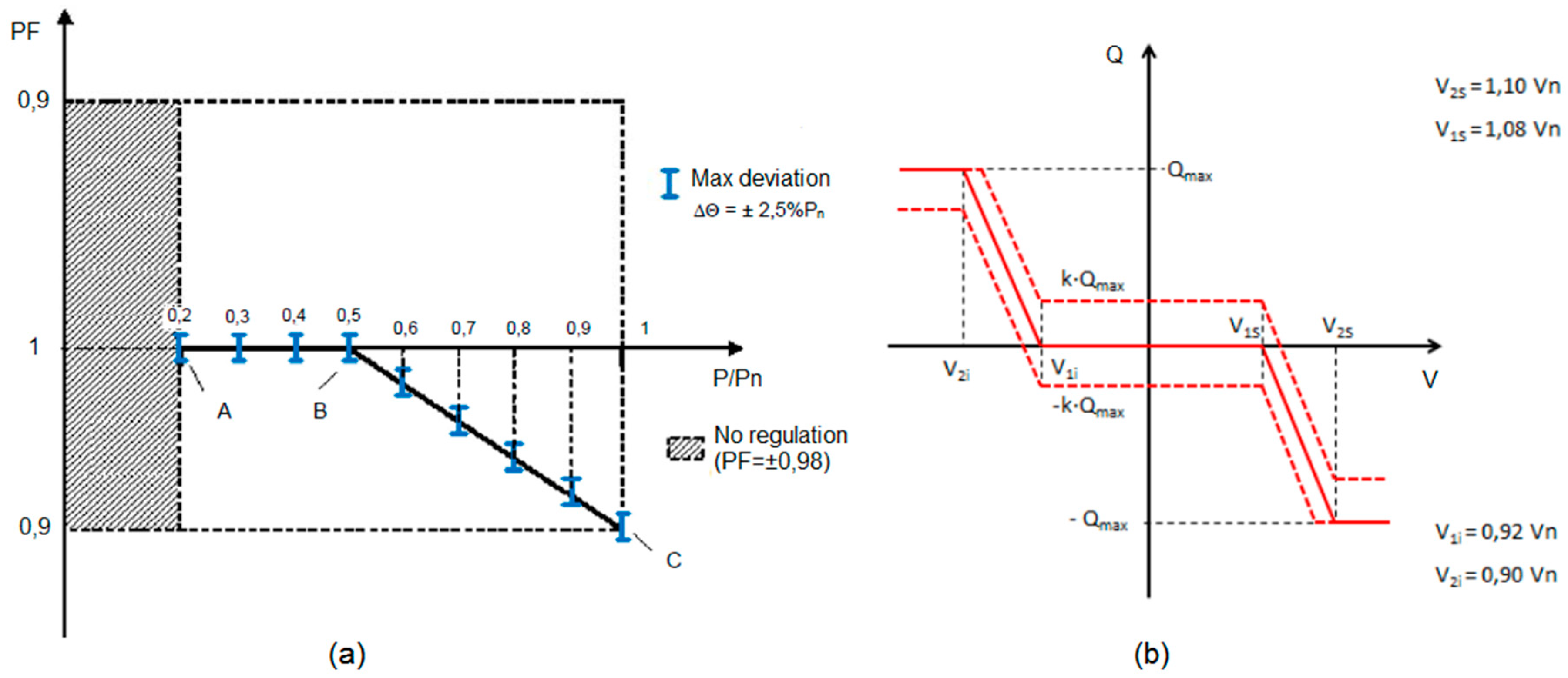
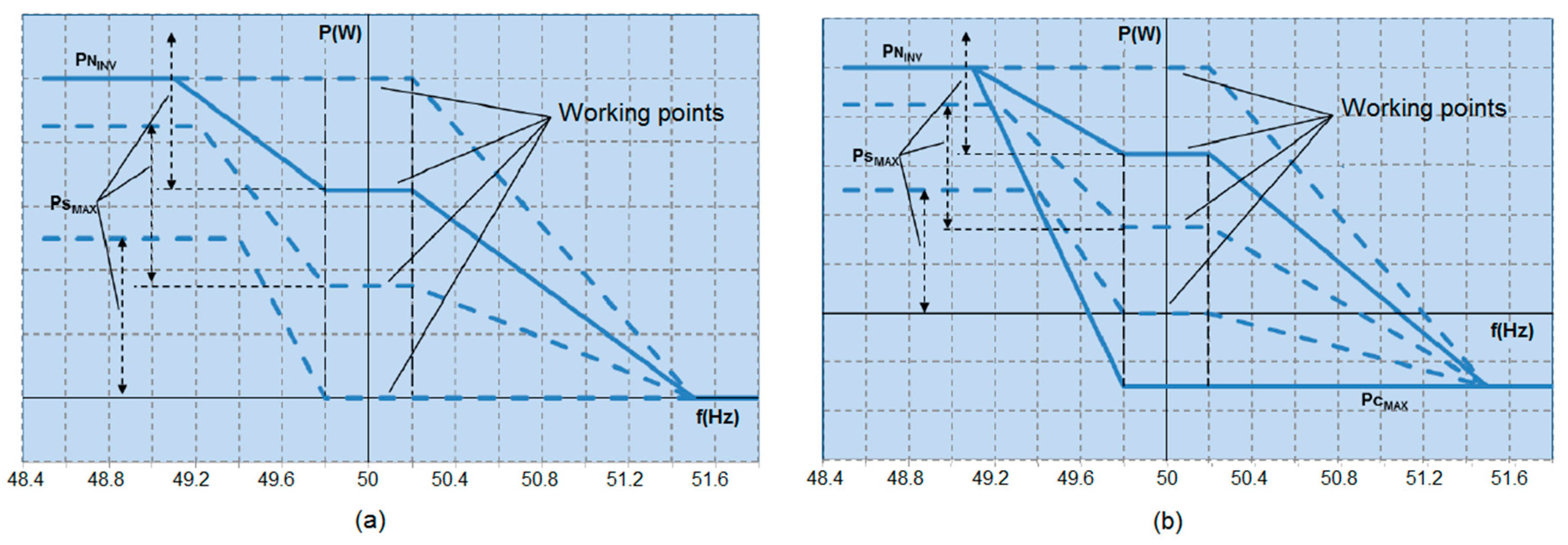

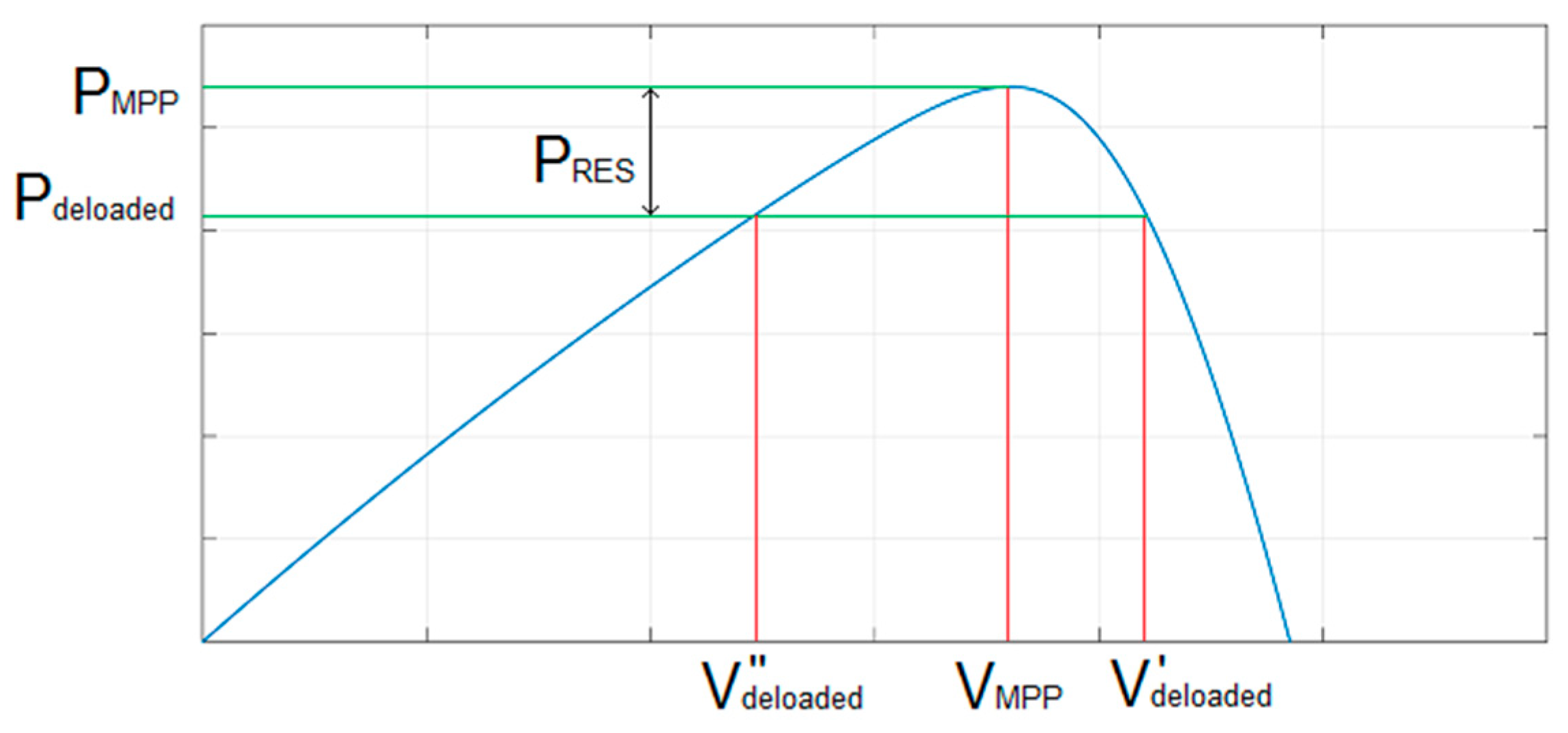
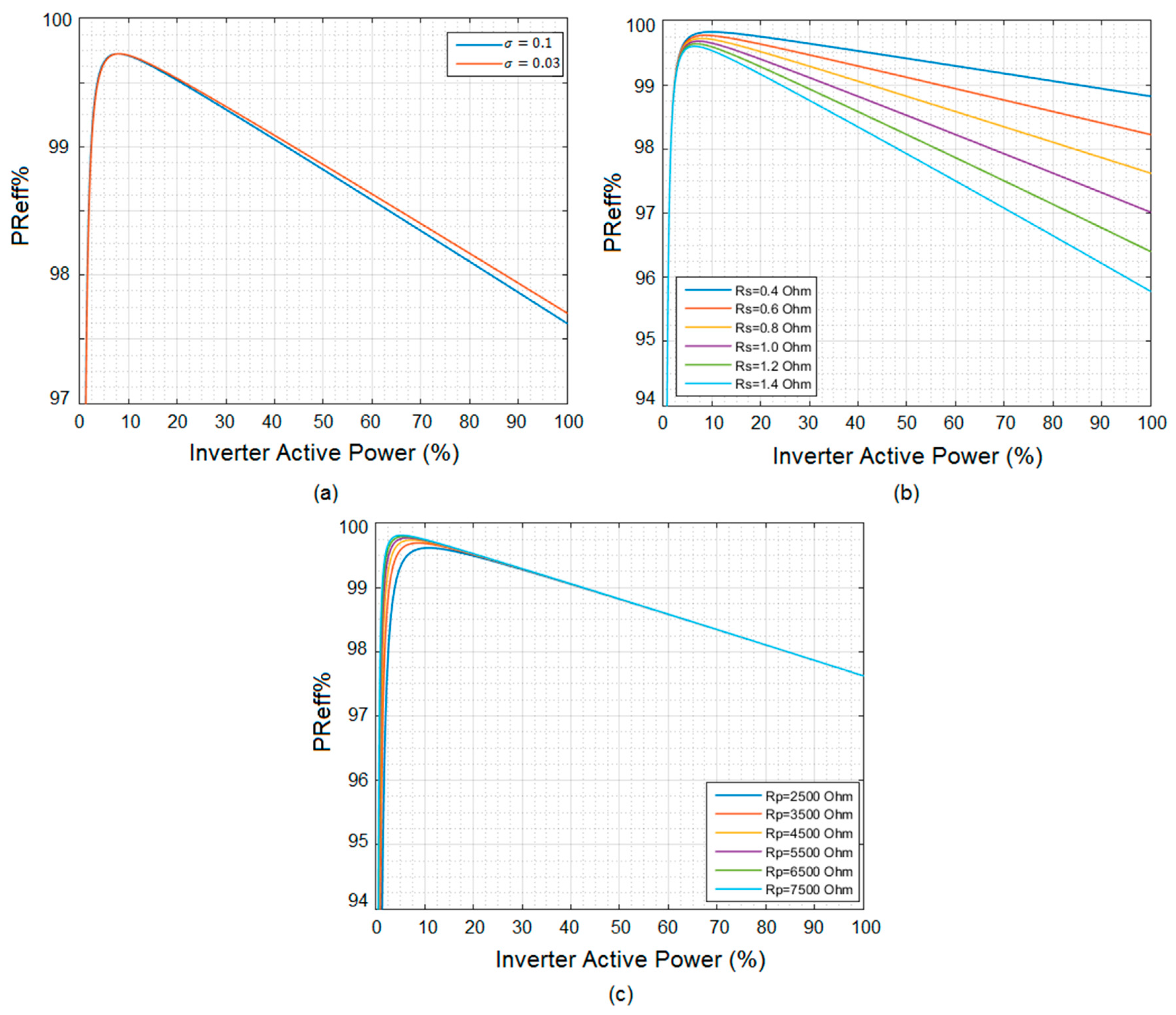

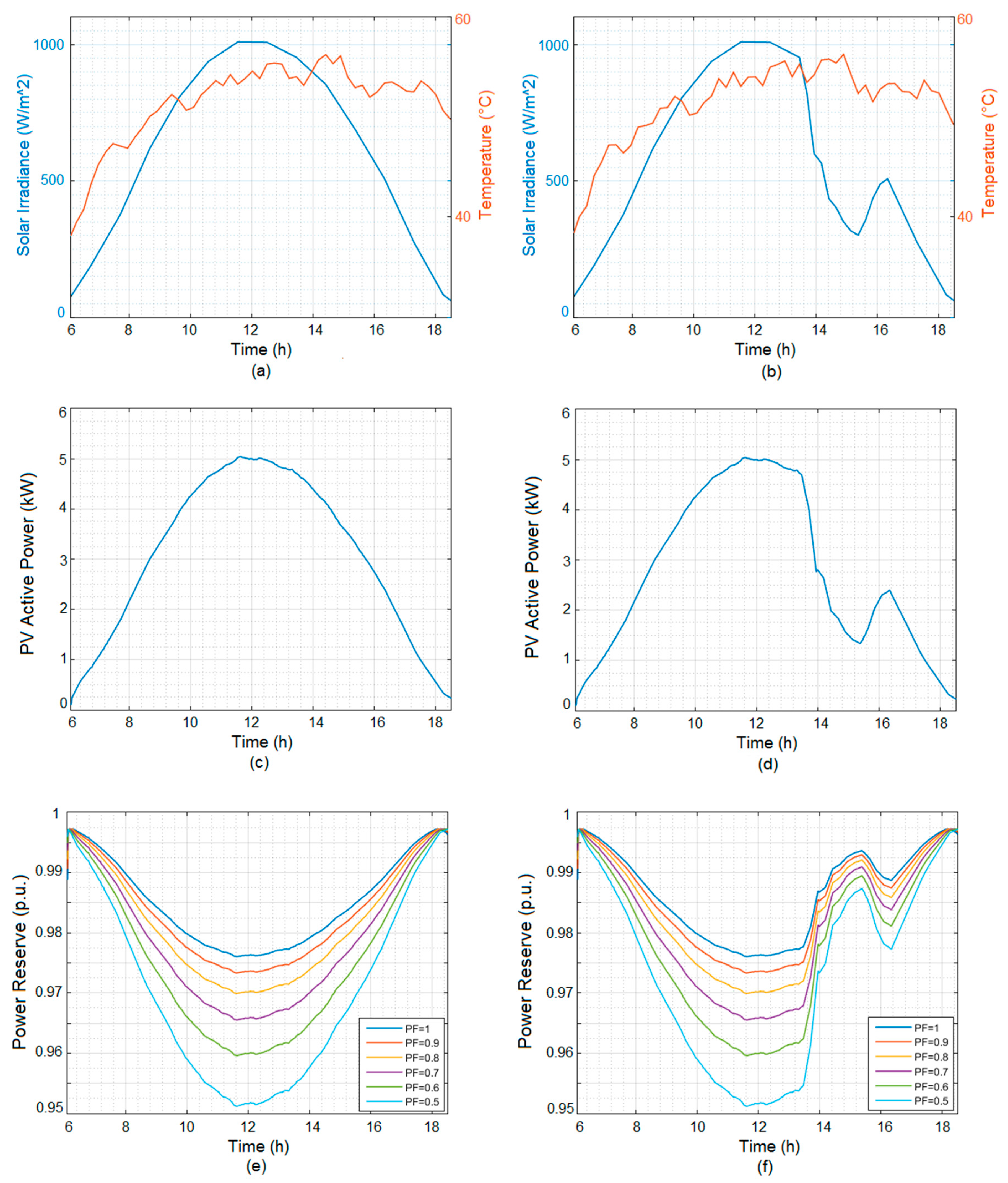
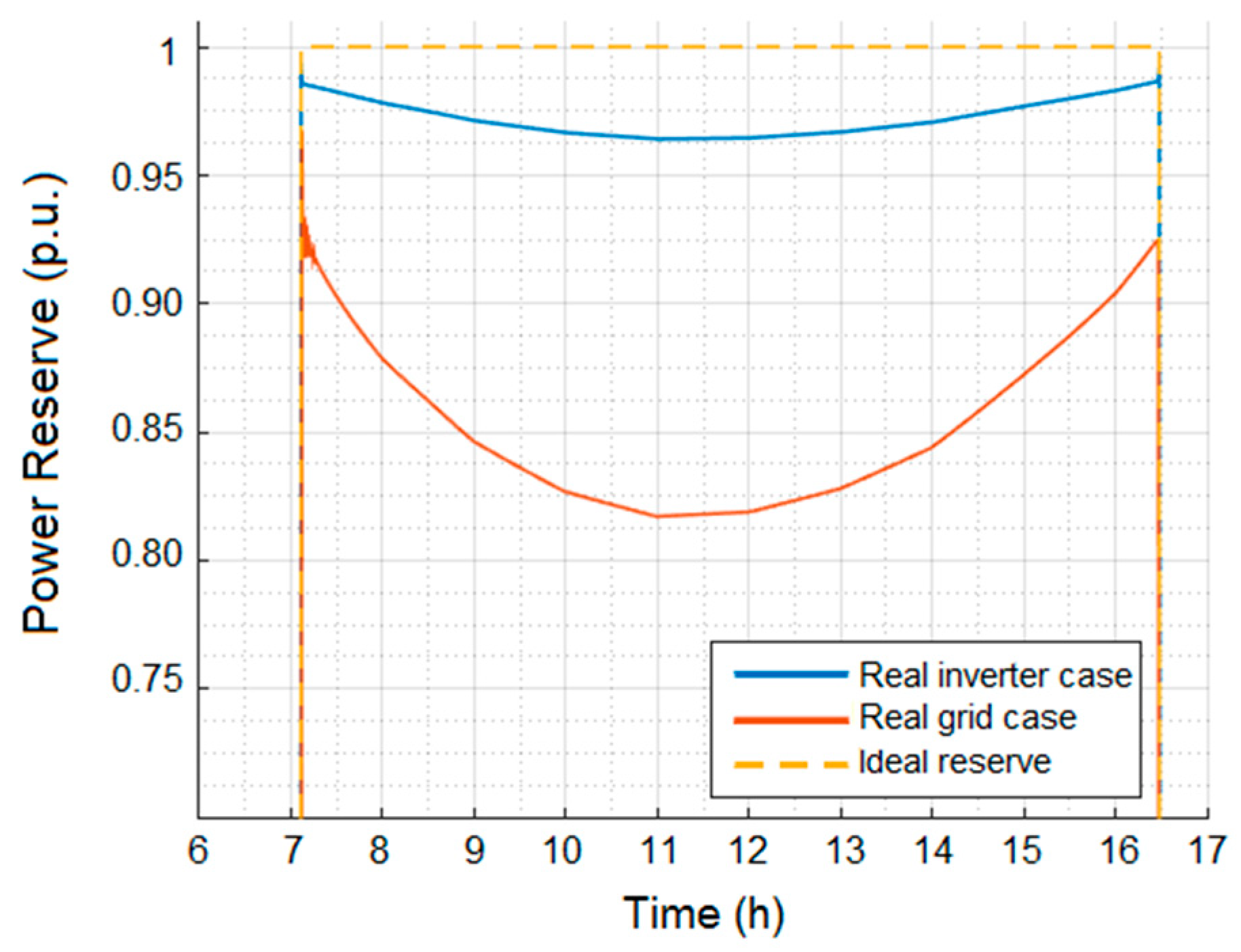
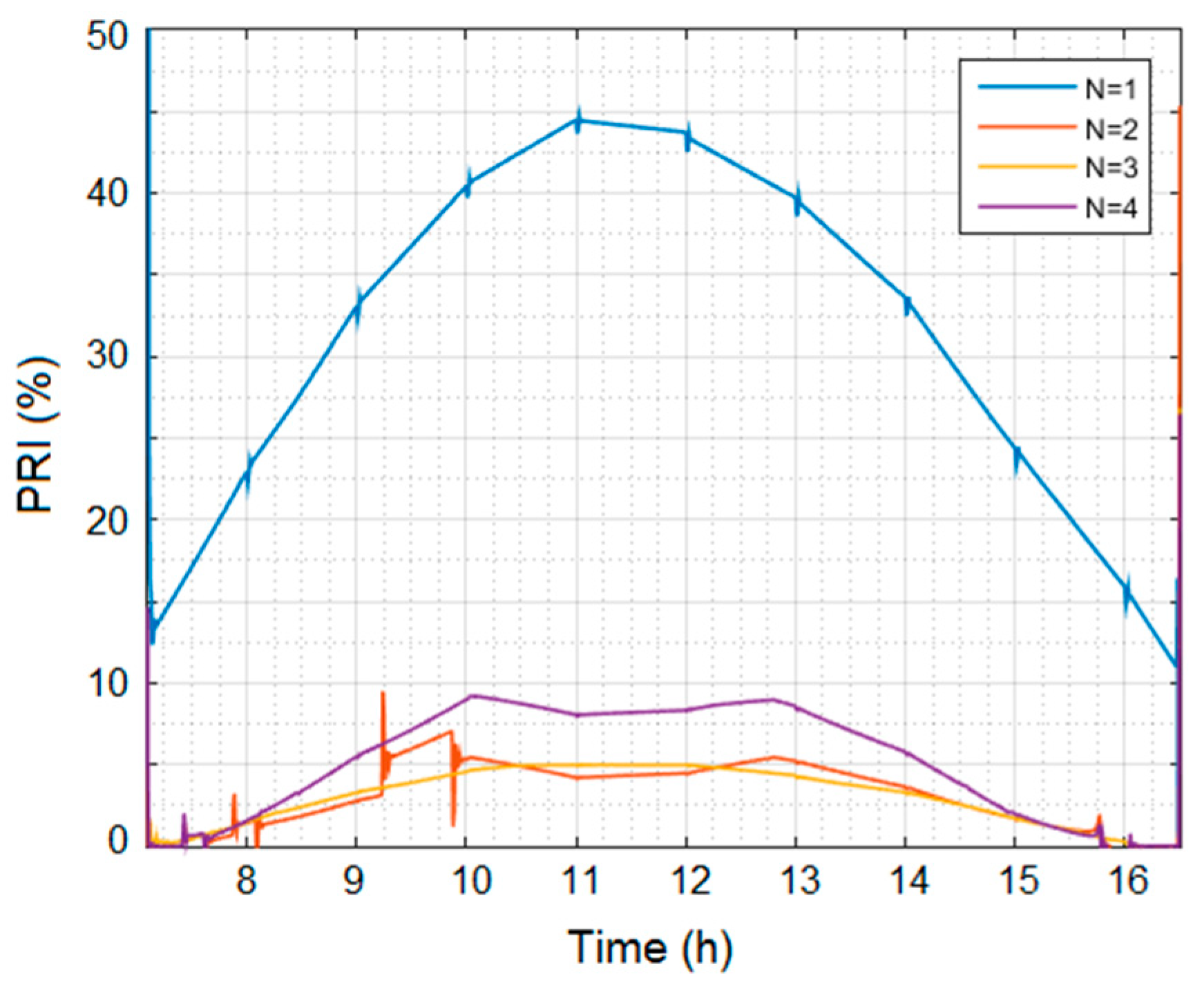
© 2020 by the authors. Licensee MDPI, Basel, Switzerland. This article is an open access article distributed under the terms and conditions of the Creative Commons Attribution (CC BY) license (http://creativecommons.org/licenses/by/4.0/).
Share and Cite
Garozzo, D.; Tina, G.M. Evaluation of the Effective Active Power Reserve for Fast Frequency Response of PV with BESS Inverters Considering Reactive Power Control. Energies 2020, 13, 3437. https://doi.org/10.3390/en13133437
Garozzo D, Tina GM. Evaluation of the Effective Active Power Reserve for Fast Frequency Response of PV with BESS Inverters Considering Reactive Power Control. Energies. 2020; 13(13):3437. https://doi.org/10.3390/en13133437
Chicago/Turabian StyleGarozzo, Dario, and Giuseppe Marco Tina. 2020. "Evaluation of the Effective Active Power Reserve for Fast Frequency Response of PV with BESS Inverters Considering Reactive Power Control" Energies 13, no. 13: 3437. https://doi.org/10.3390/en13133437





